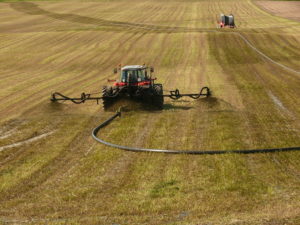
Liquid manure targeted to forage crops has value beyond the convenience of application. With phosphorus and potassium prices increasing over time, no one has to tell a livestock producer that manure has value. With the realization of the manure nutrient value, there has been a greater effort to target the manure beyond just corn crops and to fields further away from the manure storage.
Manure applied to forage crops when soil conditions are more favourable and when the equipment, labour and time pressures from a busy planting season are past will also replenish phosphorus and potash that is removed with the hay. Considering an average yielding 3-cuts/yr alfalfa-grass mix; a 3 year forage stand removes about 900 lb/ac of K20 – a 45 ppm decrease in the K soil test. Potash is important in stalk strength and in promoting persistence.
Manure applied to forage crops also increases forage yields and forage quality. On a dry year, manure applied at higher rates (i.e. from a lagoon or runoff storage) will often supply much needed water, which will have a dramatic effect on yield. Field trials that spanned both wet and dry years showed a consistent yield increase (10% average) to surface applied manure. Quality also improved with manure application — 5.6 % more milk per ton of forage. When quality and yield were combined over 12% more milk per acre of forage harvested was measured where manure application occurred. (MILK91 and MILK 2006 software program – University of Wisconsin)
There are a few key points to consider in applying manure to forage crops:
- Apply as soon after harvest as possible, before regrowth, since tire traffic over new growth will reduce yields. During a wet harvest season, application may be better delayed until after the next cut.
- Ideal application rates of liquid dairy manure (between 3,000 to 4,000 gal/ac) provide in the range of 50-45-90 lbs/acre of available N-P205-K20. An analysis at time of application will provide more accurate nutrient information.
- Application of liquid manures that supply more than 75 lbs/ac as ammonium N should be avoided on sunny, hot days to prevent burn to new tissue.
- Uniform application is important.
- Dairy manure nitrogen composition is about 50% ammonia and 50% organic nitrogen, although ammonia increase as dry matter decreases.
- Ammonia loss can be as high as two-thirds of the ammonia portion of the manure nitrogen, and is highest in the 1st 24 hours after application and is highest in areas where higher rates have “pooled”. Rainfall after application reduces ammonia loss.
- Solid manure application can also be beneficial to forage stands, but unless manure is of a consistency that allows uniform thin application (no large clumps), there is the potential for smothering to occur. Moving solid bed-pack manure from the barn to a temporary field storage in early spring helps improve manure composition.
- Manure applied to fields where hay will be baled, wrapped and ensiled should be avoided since high levels of butyric acids could result in small pockets of the baleage where manure contact with forage caused improper fermentation. This is not an issue with haylage.
- Sample the manure applied to forages and send for analysis so that nutrients applied can be credited.